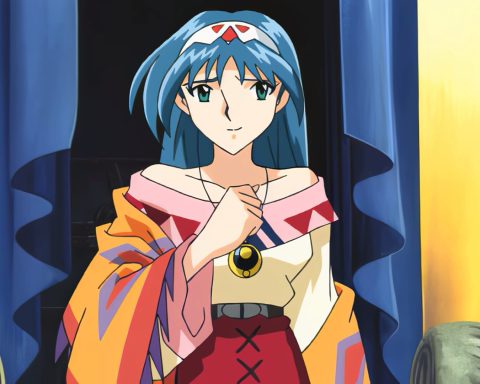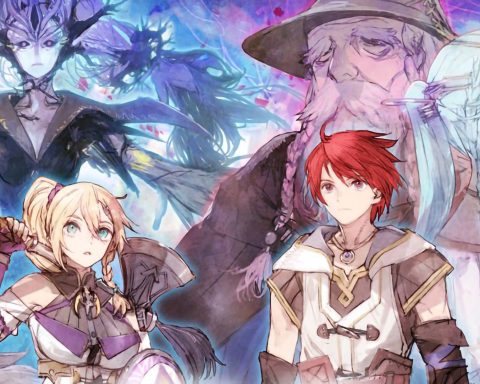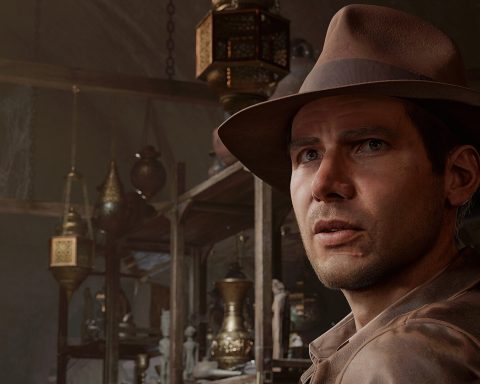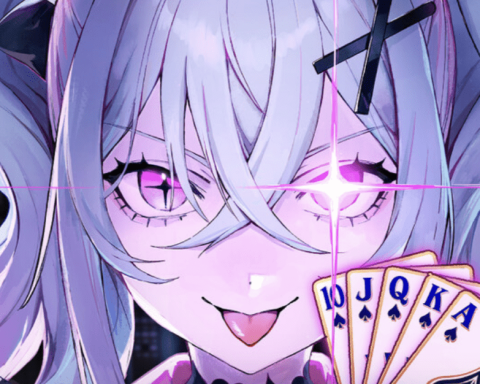htoL#NiQ: The Firefly Diary has a title that is impossible to pronounce, but it is not a random collection of letters there before the colon. That “htoL#NiQ” makes perfect sense the moment you start playing, because it is alien, otherworldly, and perfectly represents the kind of sheer, wonderful hostility that you’ll experience as you play through this game.
Mion, a young, mute girl, wakes from a slumber to find herself in a desolate world of ruin and no memories of how she got there or why the world is this way. Soon, though, she is accompanied by two fireflies – one that exists in the light, and one that exists in shadow, and together, the trio begin a journey through a pure vision of hell in order to work out what’s going on, and to escape the nightmare that they find themselves in.
It’s no exaggeration to call the world of The Firefly Diary ‘hell’, either. Mion’s journey takes her through a sadistic kind of deadly environment, with gauntlets of vicious traps and shadow monsters to run from, manipulate, or trick her way past. Worse, she is completely powerless to fight against all of these threats. It’s no small feat to be the most difficult game going around, but this one pushes for that title. The protagonist in the Souls games has swords, armour, and weapons. He or she can fight back, even if the beasts have a massive power advantage. The boy in Limbo can at least jump and is quite easy to control – he might not be able to fight but he does respond to your every whim. Mion, meanwhile, has a ponderously slow walking pace, her two allies can’t do much more than activate switches and turn taps on, and even the controls themselves fight against the player.
See, you can’t control Mion directly. To inspire her to move, you instead move the light fairy, which she will then follow like the mythical will-o’-the-wisp would lead explorers trekking through swamps to their doom. But she won’t respond immediately to the movement of the fairy, meaning that if there’s a need to move quickly to avoid running into a trap or monster, you can kiss goodbye to Mion: she’s going to die. Even simple actions, such as climbing a ladder, is a laborious process. It’s possible to manipulate the fairies using the front and rear touchscreens, or the control sticks (the latter allowing you to play on the PlayStation TV as well), and while either option will be as clunky at the end of the adventure as it is in the beginning, it’s a deliberate, methodical clunkiness that enhances the game’s themes and challenge in a way that is consistent, and therefore fair.
The result of this setup is a puzzle game where you’ll need to use the two fairies to manipulate various objects both in the world and its shadow equivalent in order to create a safe passage that Mion can creep her way through, as slow as she moves. It doesn’t take long for these puzzles to be quite taxing, either. With the touch of a button you can pause time and the screen will switch into the shadow realm. There, you can move the shadow fairy about, but he can only move through the shadows that are left by people and objects in the real world. At times you’ll need to wait for objects to move to the precise right place to shift into the shadow world so that their silhouettes line up so the fairy can move through them. In one very early example you need to let a monster actually catch Mion, and then raise his arm in order to strike her down, before activating the shift to the shadow world so that the monster’s upstretched arm can be used as a conduit for the shadow fairy to reach the ceiling, where he can activate a rock fall, burying the monster.
The precise timing and finesse that is required to overcome most of The Firefly Diary’s puzzles, and indeed the reality that you will often need to put Mion in a perilous position, make for a brutal game where character death is common. The trial-and-error process by which puzzles can be worked out means that progress is never insurmountable, and a generous checkpoint system prevents the regular deaths of Mion from being frustrating from a mechanical point of view, but the way that Mion perishes never ceases to be confronting. Her deaths are gory and incredibly bloody, and are accompanied by a wet thud or slashing tone to convey a real sensation of pain on the player. Mion remains mute, so there’s no scream of pain, but with each death the camera zooms in close and Mion’s vacant look back at the player never stops being affecting. Like with games such as Never Alone or Murasaki Baby I understood the need for the occasional character death so I could figure out how to overcome its puzzles, but equally, as with those two games I felt terribly responsible with each and every death.
Mion’s slow pace of movement would make exploring boring were the traps not coming thick and fast, but even if there were vast, empty landscapes to walk though, I wouldn’t have it any other way. Because she is mute, much of Mion’s personality is conveyed through that slow gait of hers, as it represents just how vulnerable she is in a world where everything and anything can and will tear her to pieces. From the decrepit machinery through to the later nightmarish visions that I won’t spoil in this review, The Firefly Diary might not be as black as a game like Limbo, but it is every bit as nihilistic, with the ever-growing sense of dread telling players that regardless of the progress they make through it, there’s no happy ending at the end of this particular tunnel.
Mion also has two little horns of wood sticking out of her head, granting her a faintly demonic aura that should immediately set you off that there’s a mystery to the game and perhaps she’s not quite as innocent as you might want to see in her adorably cute features. This is reinforced with the backstory flashbacks that you’ll come across through the quest. The first couple are perfectly charming, pleasant experiences where Mion will be fetching a beloved toy for a pet or some food for an elder that you assume is her father, but despite the innocence of the setting the soundscape and grainy visual style that the cut scenes adopt make it hard to quite shake the impression that there’s something sinister going on in the background that is going to be revealed, slowly and shockingly. Again, I don’t want to spoil anything in the review, but the revelations of this game are worth putting up with the sadistic gameplay.
Difficult games are polarising by their very nature, and The Firefly Diary will be no different. However, here we have a game that offers a brutally dark theme and sheer precision with its atmospherics, combined with incredibly difficult, but incredibly well designed puzzles to overcome. The result is a visionary project that might not resonate with every player, but everyone should try it because if it does resonate, then it’s going to be an unforgettable experience.
– Matt S.
Editor-in-Chief
Find me on Twitter: @digitallydownld

.jpg)







